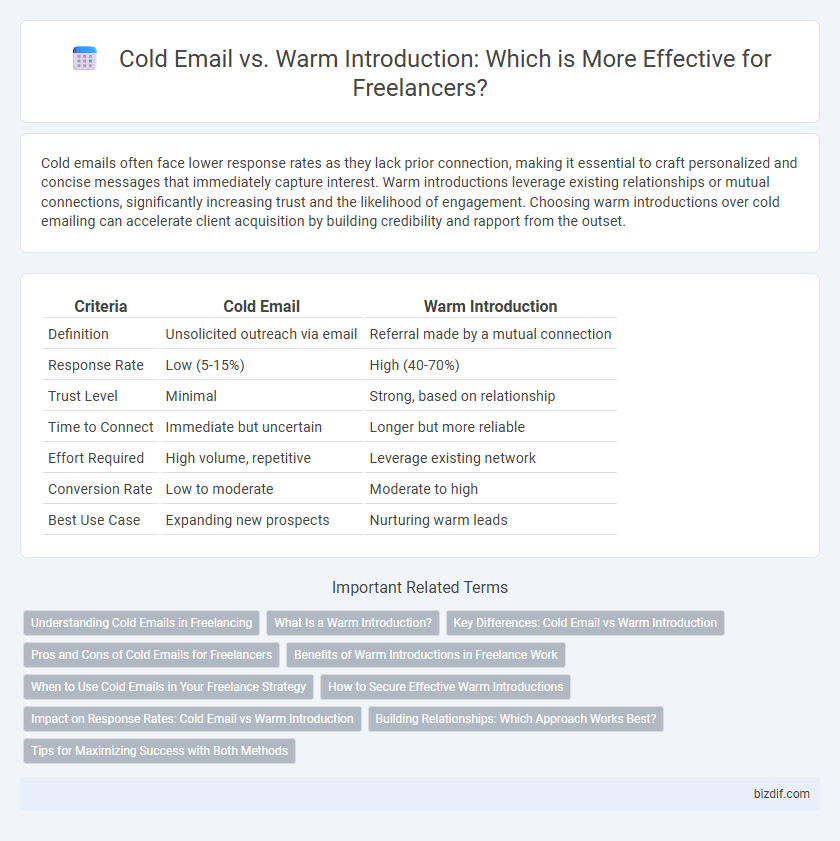Cold emails often face lower response rates as they lack prior connection, making it essential to craft personalized and concise messages that immediately capture interest. Warm introductions leverage existing relationships or mutual connections, significantly increasing trust and the likelihood of engagement. Choosing warm introductions over cold emailing can accelerate client acquisition by building credibility and rapport from the outset.
Table of Comparison
| Criteria | Cold Email | Warm Introduction |
|---|---|---|
| Definition | Unsolicited outreach via email | Referral made by a mutual connection |
| Response Rate | Low (5-15%) | High (40-70%) |
| Trust Level | Minimal | Strong, based on relationship |
| Time to Connect | Immediate but uncertain | Longer but more reliable |
| Effort Required | High volume, repetitive | Leverage existing network |
| Conversion Rate | Low to moderate | Moderate to high |
| Best Use Case | Expanding new prospects | Nurturing warm leads |
Understanding Cold Emails in Freelancing
Cold emails in freelancing involve reaching out to potential clients without prior contact, requiring precise targeting and personalized messaging to capture attention effectively. Crafting a compelling subject line and demonstrating clear value tailored to the recipient's needs increases response rates significantly. Metrics such as open rates, response rates, and conversion rates are critical to evaluate the success of cold email campaigns in securing freelance projects.
What Is a Warm Introduction?
A warm introduction in freelancing occurs when a mutual connection personally recommends or connects you to a potential client, creating immediate trust and credibility. This method often results in higher response rates and stronger professional relationships compared to cold emails, which are unsolicited and lack prior rapport. Leveraging platforms like LinkedIn or industry networks can facilitate effective warm introductions that accelerate project opportunities.
Key Differences: Cold Email vs Warm Introduction
Cold email involves reaching out to potential clients or collaborators without prior contact, relying on carefully crafted messages to generate interest and establish trust. Warm introduction leverages existing relationships or mutual connections to create immediate credibility and higher response rates. Key differences include the effectiveness of trust-building, personalization level, and conversion potential, with warm introductions often yielding quicker, more positive engagements.
Pros and Cons of Cold Emails for Freelancers
Cold emails for freelancers offer the advantage of reaching a broader audience without relying on existing networks, enabling access to untapped potential clients. However, cold emails often face lower response rates and can be perceived as intrusive, requiring carefully crafted messaging to stand out in crowded inboxes. Despite these challenges, cold emailing remains a cost-effective strategy to generate leads when personalized targeting and follow-up tactics are applied effectively.
Benefits of Warm Introductions in Freelance Work
Warm introductions in freelance work significantly increase trust and credibility, leading to higher response rates and stronger client relationships. Clients are more likely to engage and commit when referred by a mutual connection, reducing the time spent on pitching and follow-ups. This method also often results in better project alignment and long-term collaboration opportunities, enhancing overall freelance success.
When to Use Cold Emails in Your Freelance Strategy
Cold emails are most effective when entering new markets or targeting potential clients with no prior connection, allowing freelancers to expand their network beyond immediate contacts. They help initiate conversations with decision-makers who might be unaware of your services, especially when personalized and research-driven. Using cold emails strategically can generate leads during slow periods or when scaling freelance business outreach efforts.
How to Secure Effective Warm Introductions
Securing effective warm introductions hinges on leveraging genuine relationships within your professional network and clearly articulating mutual value to the introducer. Personalizing requests by highlighting shared goals or past successes fosters trust and increases the likelihood of a positive response. Utilizing platforms like LinkedIn to engage meaningfully before requesting an introduction also enhances credibility and connection strength.
Impact on Response Rates: Cold Email vs Warm Introduction
Warm introductions yield significantly higher response rates compared to cold emails due to established trust and personalized connections. Cold emails often face low engagement, with average response rates ranging from 1% to 5%, while warm introductions can boost response rates up to 30% or more. Leveraging referrals and mutual networks enhances credibility and increases the likelihood of positive client interactions in freelancing.
Building Relationships: Which Approach Works Best?
Warm introductions tend to build stronger relationships in freelancing due to the trust and credibility transferred from a mutual connection, increasing the likelihood of a positive response. Cold emails can reach a broader audience quickly but often suffer from lower engagement rates because recipients may view them as unsolicited or impersonal. Prioritizing warm introductions leverages existing networks, fostering deeper connections and higher conversion rates in client acquisition.
Tips for Maximizing Success with Both Methods
Craft personalized messages with clear value propositions to increase response rates in both cold emails and warm introductions. Research the recipient's background and tailor communication to address their specific needs or pain points. Leverage social proof, follow up consistently but respectfully, and track engagement metrics to refine your approach and boost conversion success.
Cold Email vs Warm Introduction Infographic

 bizdif.com
bizdif.com